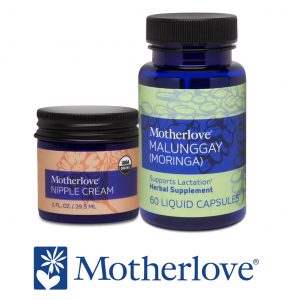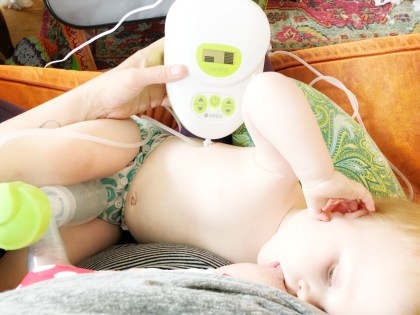by Jessica Martin-Weber

This post made possible by the generous support of Ready Rocker
Use Code: TLB-30 for 30% off your cart on readyrocker.com
There’s something comforting about knowing you have a space just for you, all set up with your favorite comforts. When you get there, you can really relax, you feel safe, everything you need is right there, and you can focus on what is really important to you. That is even more true for breastfeeding.
While lactation and baby or toddler feeding happens where it needs to, when it needs to, it can help to have a regular comfortable space or two set up for when you’re home with everything in easy reach so you can just focus on what’s really important. Being comfortable, able to focus, and able to relax can make a difference in getting a latch that works for you and baby without pain, encourage let-down, prevent stress on your body, allow for more complete postpartum healing, and support different positions.

To set up a lactation space you’ll love, keep in mind that one-size-doesn’t-fit-all. We’re all different and that’s great! What works for one may not be what works for another. So get specific about what you like and don’t worry if you’re the only one doing it that way. Your lactation space, like your lactation journey, should be as unique as you and your baby are. Don’t pressure yourself to have the instagram ready lactation journey or breastfeeding space, let your journey unfold, seeking help and using the tools you need in the process. It may not be perfect (whatever that means) but it will be real and that is beautiful.
Some considerations:
Since nursing can be expected to happen at least 8-16 times a day (such a wide range) and be up to 30 minutes a session (and honestly, sometimes longer while you and baby are first learning), meaning 8 or more hours a day spent JUST feeding your baby, it’s important to be as comfortable as possible for those feeds. With that in mind, here are some considerations to take into account when setting up your lactation space.
Picking a spot- get comfy!
- Quiet and away or in the middle of things?
- Comfortable seating options?
- Is there room for position options and changes such as football hold or laid back positions?
- Room for others or just you and the nursling?
- Do you need to be near an outlet, entertainment remote controls, etc.?
- Lighting- are you able to control the lighting to make it brighter or dimmer?

Once you’ve decided the specific space or two- it may work best for there to be multiple areas set up as a lactation space depending on the time of day or other needs of the family, it can save a lot of stress and headache to have the items you may need or will make you more comfortable within easy reach. What that is depends on each individual’s unique needs but there are some most find handy.
A basket, rolling cart, small tub, caddy, or bag nearby to contain the smaller items makes it easy to have everything you may need in addition to the seating and larger elements of your lactation space. This way you can move your lactation space as needed with easily portable items contained and elements that have multi-function or are portable can streamline the process once you’re more comfortable breastfeeding in other areas. This is why I love a charging adapter with multiple port types and the Ready Rocker for a rocking chair option I can take anywhere.
May be helpful to have…
- Footstool
- Water/drink (trust me, you’re going to get thirsty)
- Snacks (nothing like breastfeeding hunger!)
- Ready Rocker
- Nursing pillow or other supports
- Cozy options (blanket, sweater, etc.)
- Nursing pads
- Heat/cold packs
- Helpful tools (i.e. nipple cream, lactation massager, burp cloths, hands-free-pumping-bra, etc.)
- Fidget or safe toy
- Breast pump or silicone suction expression cup
- Phone charger
- Speaker or earbuds
- Entertainment (phone, book, tablet, etc.)
Now all that’s needed is the baby!
Oh, and while not a part of the actual space, set-up for each lactation session by being sure you empty your bladder first and washing your hands. You don’t want to regret that step, that’s a sure way to make even the most comfortable spot miserable!
How do you have your lactation and baby feeding space set up? Is there anything you’d add to our considerations?
_________________________
If this resource was helpful for you, consider helping The Leaky Boob by giving back. Help us keep our information, support, and resources free by becoming a patron and get access to exclusive content just for our supporters. Join here today.
______________________________























 Drawing from a diverse background in the performing arts and midwifery, Jessica Martin-Weber supports women and families, creating spaces for open dialogue. Writer and speaker, Jessica is the creator of
Drawing from a diverse background in the performing arts and midwifery, Jessica Martin-Weber supports women and families, creating spaces for open dialogue. Writer and speaker, Jessica is the creator of 


























 Tracey Montford created Cake Lingerie in 2008 when she wanted bras that worked for the modern mother. With a background in creative arts and teaching, she never imagined having her own business, let alone creating one out of her own personal need. She now owns and runs Cake Lingerie from Sydney, Australia with her husband, Keith and their children.
Tracey Montford created Cake Lingerie in 2008 when she wanted bras that worked for the modern mother. With a background in creative arts and teaching, she never imagined having her own business, let alone creating one out of her own personal need. She now owns and runs Cake Lingerie from Sydney, Australia with her husband, Keith and their children. Drawing from a diverse background in the performing arts and midwifery, Jessica Martin-Weber supports women and families, creating spaces for open dialogue. Writer and speaker, Jessica is the creator of TheLeakyBoob.com, co-creator of BeyondMoi.com, freelance writer, and co-founder of Milk: An Infant Feeding Conference. Jessica lives with her family in the Pacific Northwest and co-parents her 7 daughters with her husband of 22 years.
Drawing from a diverse background in the performing arts and midwifery, Jessica Martin-Weber supports women and families, creating spaces for open dialogue. Writer and speaker, Jessica is the creator of TheLeakyBoob.com, co-creator of BeyondMoi.com, freelance writer, and co-founder of Milk: An Infant Feeding Conference. Jessica lives with her family in the Pacific Northwest and co-parents her 7 daughters with her husband of 22 years.







 Dominique Bellegarde is a Certified Lactation Counselor (CLC) who has worked with Women, Infant & Children (WIC) for more than 10 years as a peer counselor helping mothers meet their breastfeeding goals from home and hospital visits to supportive text messaging and video chats. Dominique teaches a Breastfeeding class every other week at Codman Square Health Center for pregnant women and their partners. She also co-facilitates the well-known
Dominique Bellegarde is a Certified Lactation Counselor (CLC) who has worked with Women, Infant & Children (WIC) for more than 10 years as a peer counselor helping mothers meet their breastfeeding goals from home and hospital visits to supportive text messaging and video chats. Dominique teaches a Breastfeeding class every other week at Codman Square Health Center for pregnant women and their partners. She also co-facilitates the well-known  Fortune Glasse Cotten is a mother, attorney, and breastfeeding advocate. Her own experience birthing and exclusively breastfeeding her son has led her on this journey seeking to support other mothers of color. She holds a Bachelor’s Degree from Columbia University and a Juris Doctor from the University of Michigan Law School. Fortune lives in Las Vegas, Nevada with her husband and son.
Fortune Glasse Cotten is a mother, attorney, and breastfeeding advocate. Her own experience birthing and exclusively breastfeeding her son has led her on this journey seeking to support other mothers of color. She holds a Bachelor’s Degree from Columbia University and a Juris Doctor from the University of Michigan Law School. Fortune lives in Las Vegas, Nevada with her husband and son.
